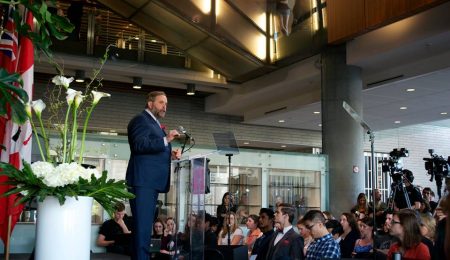Candidates impress youth turnout
The Liberal, Green and New Democratic Party federal election candidates for Ottawa Centre met Sept. 25 at the National Gallery of Canada to debate LGBTQ+ issues in an event organized by the One World Film Festival.
The One World Film Festival programs documentary films from around the world that focus on environmental issues, social justice, and human rights.
“Since we have this election coming up, we thought this year we would focus on election issues,” said Jessica Ruano, the festival’s manager. “Each day of the festival is focused on an idea, concept, or issue. Tonight is about youth, the power of the arts and LGBTQ issues.”
Candidates debated youth homelessness, and Bill C-279, a bill seeking to include gender identity as a prohibited ground for discrimination that died in the Senate. Candidates also discussed refugees and asylum-seekers, the decriminalization of HIV and the absence of Conservative candidate Damian Konstantinakos from the event. A Conservative candidate was also missing at a debate concerning LGBTQ+ issues in Toronto on Sept. 24.
Don Cummer, a spokesperson for the Konstantinakos campaign, said Konstantinakos had prior engagements, and that there was confusion because the event was labeled as a regional debate. It was held in the Ottawa-Vanier riding, so they thought the Conservative candidate for Ottawa-Vanier, David Piccini, would be attending.
Green Party candidate Tom Milroy said Konstantinakos has been absent from several of the campaign events, including a debate at the Ottawa Mosque.
The crowd contained a large percentage of youth and students, which NDP candidate Paul Dewar said is a good sign, though not a surprise. He said that despite the decreasing youth voter turnout, which was at 38.8 per cent in the 2011 federal elections, he has historically found the youth of Ottawa Centre to be engaged.
“It’s not that they’re not interested, it’s that often there’s another conversation going on than what’s going on in Parliament and in party platforms,” he said. “I hope this debate will generate interest, and for young people to see that these issues are considered by politicians, and by some of the parties, anyhow.”
Emily Sams, a second-year conflict studies and human rights student at the University of Ottawa, said she thought the organizers and candidates did a good job of covering the salient points, but that she wished they had further discussed aboriginals and other minority groups to add intersectionality to the debate.
“Ultimately, LGBTQ issues are something that a large percentage of our population face, and yet it’s one of the most under-addressed issues, I would say, in the federal platform,” she said.
Jeremy Dias, director of the Canadian Centre for Gender and Sexual Diversity, said the LGBTQ+ community and U of O grad is facing a dire time right now, because the community continues to suffer from high suicide rates, homelessness rates, dropout rates and drug and alcohol rates.
According to the Canadian Mental Health Organization, LGBTQ+ youth face 14 times the risk of suicide and substance abuse compared to their heterosexual peers.
“We really want people to be considering minority communities when they’re making their vote and making their decisions,” he said. “I think it speaks to a party’s morality and general moral compass when it comes to Canadian issues.”





